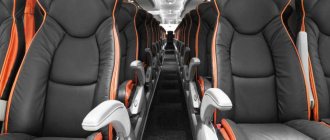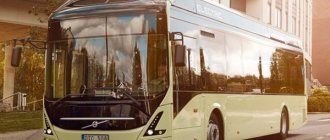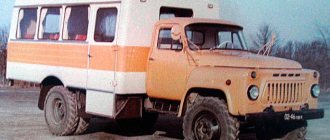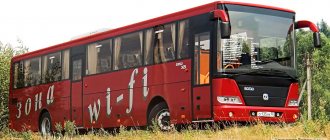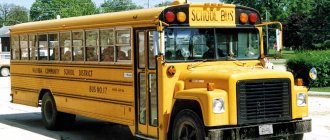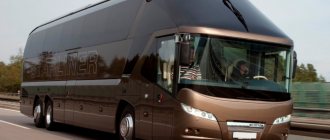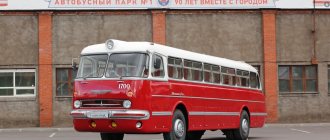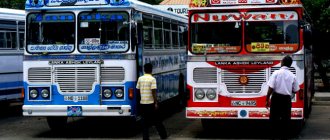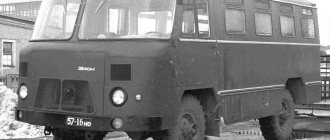Home page » Buses » Manufacturers » SCANIA
Scania Interlink bus. Scania Photos
Several large enterprises operate successfully in Sweden, the main or one of the main activities of which is the production of buses. Scania is one of the leading companies not only in Sweden, but also in Europe and the world market for the construction of passenger transport. The manufacturer produces a fairly extensive selection of equipment , the numerous advantages of which ensure the interest of potential buyers and customer demand. To get acquainted with the company from Sweden and its equipment, this article is presented.
About the company: history, country, who the manufacturer is, whose production and more
Scania AB is a Swedish company founded in 1891 and is a manufacturer of trucks, buses, and engines. its own chassis to many third-party body companies. The company has been producing passenger transport since 1920.
Scania company logo. Photo Wikipedia
The company's headquarters is located in Sweden, in the city of Södertälje, which is actually a suburb of Stockholm. Production is located not only in Sweden, but also in other countries: Argentina, Brazil, the Netherlands, Poland, Russia, France. Thus, buyers are provided with cars produced in different countries, including those assembled in Russia. Since 2015, Scania's parent company has been the German Volkswagen AG.
Seventh decade - from Britain to Brazil
By the beginning of the 1970s. Scania began to lose its dominant position in the bus market in Scandinavia, so rear-engine bus chassis models BR110M and then BR111M (1974–1978) began to occupy an important place in the production program. However, front-engine chassis were still popular. The most popular of them were the chassis of the BF110 (1968–1975) and BF111 (1975–1981) models, of which 6,971 units were built. The development of city buses continued to pay great attention to the environment. In 1971, production of buses of the CR111M model with a 190-horsepower 6-cylinder diesel engine and automatic transmission began. The bus was distinguished by a reduced noise level (achieved by careful sound insulation of the engine compartment), which did not exceed 77 decibels, which is lower than even modern European standards, which allow a noise level from trucks of 78–80 dBA. Until 1978, 806 buses of this type were assembled. At the same time, production of the BR145 chassis for intercity buses, equipped with a V8 diesel engine with a power of 260 hp, began. The intercity bus model CR145 (1971–1976) was produced on this chassis.
The Brazilian branch played an important role in bus production. Together with him, Scania-Bussar created the BR116 rear-engine chassis for intercity buses, which can be considered one of the most popular Scania brand products of this type. In 1977, chassis production began in Brazil, and a year later in Sweden. A total of 5,624 such chassis were built before 1982. This model was also assembled in Argentina.
In the 1970s Scania continued to expand into the British market. The stagnation of the national automotive industry in Great Britain led to the fact that the famous double-deckers began to be built on Swedish chassis. In 1973–1978 For these purposes, 663 chassis of the BR111DH model were sent to the UK, which were equipped with bodies by MCW, after which the buses received the name Scania Metropolitan. Another British firm was East Lancashire Coachbuilders in 1980–1982. built double-decker buses on the chassis of the BR112DH model.
In 1978, production of the city bus model CR112 began, which became the main vehicle of this type in the production program until 1983, and in 1980, the first articulated chassis BR112A.
In 1980, Scania-Bussar produced 1,800 buses and chassis.
Classification, technical characteristics
Each bus model has a wide range of characteristics and parameters , in accordance with each of which it is possible to classify and identify individual types of equipment. The following describes the most common properties, existing types of transport for passenger transport and characteristics that are specific to Scania buses.
Crew bus Scania P360 4X4. Photo Scan-South-East
How many seats, number of seats: 49 and more
Capacity is determined by the length of the body and the number of floors, the presence and number of options for the comfort and safety of passengers and the driver. This indicator implies both the total capacity and the number of seats only . At various times, the company's product line included and still includes large buses for covering short, medium and long distances. The average number of comfortable seats for passengers on intercity, tourist and suburban routes is approximately 55.
Internet users are particularly interested in transport options with 49 seats. Several models/modifications meet this criterion: Scania 112, Scania Touring, Scania OmniExpress. In some cases (to cover distances of no more than 100-150 km), it is possible to transport standing passengers. As a result, the total capacity of commuter models is about 100 people. Scania city buses can seat 30-35 passengers, with a total capacity of up to 100 people.
Intercity bus Scania OmniExpress K310IB 4x2. Photo Scan-South-East
Particularly large Scania vehicles are either double-decker touring/intercity vehicles, which are also used for sightseeing trips, or articulated city vehicles. In the first case, the carriage of standing passengers is prohibited, so the capacity is equal to the number of seats, which in turn is 80-90 seats. City equipment can accommodate 40-45 passengers , the total capacity is 150 people. The capacity of rotational buses is the sum of the seats in the cabin and the passenger compartment (KUNG - zero-dimension universal body). The average is 25-30 people.
Cabin layout/plan, passenger seating, seat arrangement
The diagram is a graphical representation of the location of the main structural elements and interior of the bus: driver's cabin with a seat and steering wheel, passenger seats, toilet, kitchen, wardrobe and other options, if present, aisles, storage areas, doors with steps, rear-view mirrors. Some companies provide diagrams with quantitative data , for example, the width of steps, doors, distance between passenger seats, etc.
After reviewing the interior plan, you can see the features of each type of model. City cars are equipped with a small number of seats, which are located along and against the traffic, with the back to the side walls of the body, have wide aisles and large storage areas, doors without steps, since the design is low-floor.
Scania Hiher A80 K380IB tourist bus diagram. Photo Scan-South-East
The interiors of cars for the suburbs, intercity and tourism are equipped with paired seats located along the traffic flow, narrow aisles, there are no areas for standing passengers, and the presence of options that are not equipped with cars of the first type. In order to get into the salon of high-floor, and often one and a half-story models, you need to climb several steps. All-terrain shift models have similar characteristics, but the first seats are placed facing the direction of travel.
Numbering
Numbering of passenger seats is present only in tourist and less often intercity models . Numbering in Scania models starts on the right side, opposite the driver, from the aisle-most seat. However, it should be noted that the actual location and numbering of seats in individual models and modifications may differ from the declared one . Often, carrier companies make changes to both the layout and the sequence of numbers on the seats.
Overall dimensions: length and others
The buses available in the manufacturer's model line belong to the large and extra large classes. The main parameter is body length . The average figures for different types of general purpose machines differ and are: two-axle models - 12000 mm; three-axle – 13500; articulated - 18000. The height of one-story models is approximately 3300 mm, one-and-a-half-story models - 3800, two-story models - 4200.
Tourist one-and-a-half-decker bus Scania Touring. Photo ALFASCAN
The width of the vehicle is either 2500 or 2550. The second indicator is the maximum, since the width is limited by standards in the field of passenger transport. Special-purpose equipment, in this case rotational models, requires separate consideration, since they are rarely used on public roads. Their dimensions average 9500x2500x3500 mm.
Driver's seat, instrument panel
The Swedish manufacturer offers buses that meet high standards in terms of comfort and safety for both passengers and drivers. The driver’s “services” include a spacious cabin, a comfortable seat with adjustments, and a clear instrument panel located at an accessible distance.
Scania Touring bus driver's area. Photo Scan-South-East
The presence of a whole range of electronic systems, ease and precision of steering, ergonomic driver's seat, attractive design of the dashboard, competent and thoughtful arrangement of controls, excellent visibility - the main characteristics that ensure comfort and pleasure from every trip, regardless of its length.
Fuel consumption per 100 km.
One of the most important advantages of Scania buses is their efficiency. Low fuel consumption , which is ensured by modern engines and special systems, is highly valued by owners. Low costs ensure the profitability of the activities of legal entities that own transport. The average fuel consumption for various types of models is 30-35 liters per 100 km .
Volume of the tank
The large tanks of Scania buses enable long trips without refueling. This is important both when moving in urban environments and when making long trips. The average fuel tank volume . Buses are equipped with either one or two fuel tanks.
Device inside
Interior of a Scania OmniExpress bus. Photo Scan-South-East
Depending on the type and model, Scania buses have features in their internal structure. However, it is possible to note common features :
- bright and spacious interior with significant capacity;
- a clearly thought-out layout ensures ease of boarding/disembarking and movement around the cabin;
- high-quality sound insulation, lighting, ventilation and heating ensure high passenger comfort;
- the presence of special devices ensures comfortable boarding/disembarking and movement of passengers with disabilities;
- the use of high-quality materials guarantees an attractive interior design that remains in its original form for many years;
- Large windows provide excellent visibility from any place in the cabin;
- high ceilings allow all passengers to feel comfortable.
Engines
The buses are equipped with modern, economical Scania engines that meet current standards and regulations. It is the power units that ensure the reliability and durability of the machines and guarantee excellent ride quality. The engines are distinguished by high torque and low levels of harmful emissions.
All units are designed and developed directly by Scania, guaranteeing excellent performance and optimal interaction with other machines. Scania engines operate on different types of fuel . The transverse arrangement of units in the rear or front parts of the body allows you to increase the interior area and its capacity, and also facilitates the rapid movement of passengers.
Is there a toilet and other additional options?
The basic equipment of Scania buses is distinguished by the extensive range of available functions. Initially, the models are equipped with all the necessary options to create the appropriate level of comfort. In most cases, the manufacturer offers several modifications of one model , which differ in different parameters, including the number of options. Thus, the buyer has the opportunity to choose the best option from several , having a wide selection of interior layout schemes with numerous functions. As a result, even the most fastidious client will find the right solution. In addition, the machines are modular and flexible.
Scania Citywide LF bus. Photo Scan-South-East
The modular design of the equipment allows you to adapt any model to various customer requirements regarding capacity, location of seats, placement of doors and other elements. Refurbishment of transport is no exception. This is especially true for models designed to cover medium and long distances.
Modern tourist models are equipped with spacious compartments and ceiling shelves for luggage, a dry closet, adjustable soft chairs, and individual lighting systems. Equipping the model with additional options may include equipping the car with a sleeping place for the driver, at least one more door, a kitchen, a wardrobe and other amenities.
Results for the anniversary
Currently, Scania's production program includes rear-engine bus chassis of the N and K series of types 4x2 and 6x2, front-engine chassis of the F series, as well as a whole range of complete buses for transportation in urban areas and between cities OmniCity, OmniLink and OmniExpress and the Touring model. OmniCity and OmniLink buses have articulated versions, and the OmniLink and OmniExpress series also include three-axle options. Together with the Irizar company, tourist and intercity buses Scania Irizar i4, Scania Irizar Century and Scania Irizar PB are produced, and together with Higer - Scania Higer A80 for a similar purpose. Since 2010, Slupsk, Poland, has become the center for the production of city and suburban buses. In total, in 2010, 6,875 buses and their chassis, manufactured in Södertälje (Sweden), Slupsk (Poland) and Sao Paulo (Brazil), were shipped to customers on five continents.
Third world countries have not been forgotten either. Last year, the Swedish concern invested $1 million in the development of production at the Skenya Motors plant from Rwanda, where, in addition to buses running on biodiesel, it began producing medium-capacity buses for Uganda, Kenya, the Democratic Republic of the Congo and Burundi.
The author expresses gratitude to Stanislav Kirilets for his assistance in preparing the article.
Part 1 Part 2
Popular models: A80 and others
- Scania 113 is a large bus in two versions, suitable for use on commuter, intercity and tourist trips, and can accommodate up to 121 passengers;
- Scania OmniLink is a family of two- and three-axle buses for urban travel, the base model was released in 1998;
Scania OmniLink city bus. Photo Wikipedia
- Volzhanin 52851 is a Russian-made bus, which is often classified as a Scania product, since the model was created on a Swedish-made chassis;
- Scania Higer A80 is a Chinese-made bus, created on the Scania chassis, produced since 2007 in several modifications.
Panoramic view and smooth ride
Another feature of Scania Touring is common to many European buses - remote pillars with rear-view mirrors. In Touring, they do not protrude beyond the width of the bus and are equipped with additional spherical mirror elements in the middle of the bracket for better control of blind spots and curbs. The driver has no problems with visibility: a huge panoramic windshield with invisible, but very useful heating threads and thin pillars on the sides. To help the driver, there is a small monitor on the right hand, which broadcasts images from several cameras, thanks to which you can always see overtaking vehicles, minimize blind spots and protect yourself when reversing. In the dark, xenon headlights will help you cope with the road; in daylight, LED running lights will help you recognize the bus from afar. On the right side of the “torpedo” there is a refrigerator for drinks. The chassis confidently endures road adversities, demonstrating a normal smooth ride, lazily swaying with long overhangs. Now is the time to look into the engine compartment.
DC 13 engine (400 hp, 2100 Nm) with separate cylinder heads
Features of the bus version of the engine: a “multi-layer” crankshaft pulley with a separate outlet for a giant air conditioning compressor mounted on an elastic support. For stable operation of the belt drive, an additional stretcher with a threaded coupling is used
The transmission perspective clearly indicates the excellent aerodynamics of the bus
The transmission perspective clearly indicates the excellent aerodynamics of the bus
Where can I buy
You can get acquainted with the suppliers of Scania buses in a separate section of our website. The presented companies offer a full range of Scania equipment, and also provide related services, among which rental, leasing, and re-equipment are in demand.
SCANIA, Large buses, Shift buses, High-floor buses, City buses, Double-decker buses, Brands and models of tourist buses, Intercity buses, Low-floor buses, Single buses, Extra large buses, One-and-a-half-decker buses, Suburban buses, Articulated buses, Special buses, Tourist buses
Scania buses: model range
Scania is a well-known brand under which the manufacturer of the same name produces a wide range of equipment, including passenger vehicles. Scania buses are models of large and extra-large capacity classes, designed for travel on urban, suburban, tourist and intercity routes, as well as for transporting passengers and cargo in difficult road conditions. Among their advantages, reliability, efficiency, maneuverability,…
- Further -
SCANIA, Buses, Large buses, Shift buses, High-floor buses, City buses, Double-decker buses, Rear-engine, Brands and models of tourist buses, Intercity buses, Low-floor buses, Single buses, Extra-large buses, Front-engine buses, One-and-a-half-decker buses, Suburban buses, Manufacturers, Articulated buses, Special buses, Tourist buses, Central engine
Engine compartment
The 13-liter, 400-horsepower Scania DC 13 engine of the fifth environmental class is practically inaudible inside: from the driver’s seat, all information about the operation of the power unit can be analyzed only by instruments, no noise, no vibrations.
It’s just that 2100 Nm of torque already from one thousand revolutions per minute does not require much effort, especially without passengers. Similar engines are installed on other Scania vehicles, but the bus version, in addition to adjusting the external speed characteristics, also involves some mechanical differences, mainly in the drive of auxiliary units. Therefore, there are two powerful 150 A generators, a “multi-layer” crankshaft pulley with a separate output to a giant air conditioning compressor mounted on an elastic support. For stable operation of the belt drive, an additional stretcher with a threaded coupling is used. They didn’t forget about the service console in the engine compartment, and about the additional terminals of the pneumatic system, grouped on a separate panel on the right. This engine is paired with the familiar, latest-generation Opticruise GR875 8-speed automatic transmission, without a clutch pedal. Technical characteristics of the Scania Touring K400 IB4x2NB bus
| Total weight, kg | 19 500 |
| Axle load distribution, kg | 7500/12 000 |
| Passenger capacity, persons | 51 |
| Luggage compartment capacity, m3 | 10,0 |
| Luggage compartment load capacity, kg | 770 |
Engine:
| Scania DC 13 (Euro 5) Diesel, I-6 12 800 400 at 1900 min-1 2100 at 1000–1300 min-1 |
Transmission:
| GR875 Opticruise Automated 8/1 |
| Suspension | Pneumatic |
| Brake system | Pneumatic, disc mechanisms on all axles, hydraulic retarder, EBS, traction control system |
| Tire size | 295/80 R22.5 |
| Wheel formula | 4x2 |
| Fuel tank capacity, l | 465 |
Sweden
A large number of companies engaged in the production of passenger transport operate successfully in Europe. Buses assembled at specific enterprises have their own individual parameters and features. This is due to the variety of technologies and principles used in the work. The demand among customers for machines that differ in purpose, capacity and other properties determines the specifics of the model line of each manufacturer. Original characteristics can also be noted in the equipment…
- Further -
SCANIA, Large buses, City buses, Rear-engine, Low-floor buses, Single buses, Suburban buses
Scania OmniLink
Scania OmniLink is a family of semi-low-floor buses with a two- or three-axle layout and a longitudinal engine (designed specifically for European countries) designed to transport passengers on urban routes. It is a complete product built by Scania AB, a company based in Sweden. OmniLink was released in 1998 with the index CL94UB (CL94UA in the articulated version). After the introduction of Euro-4 in 2006, the index was changed to CK230UB/CK270UB/CK310UB. On November 26, 2005, a presentation of the gas version of the bus (Scania...
- Further -
SCANIA, Large buses, Intercity buses, Front-engine buses, Suburban buses
The one who is driving
The seat in which the driver travels... A beautiful beginning, but very far from life. The work of a driver is not like a walk. Therefore, the entire environment in the cockpit should be in a working mood. I found the decision to make the panel on the left angled towards the driver interesting. The symbols on the keys do not disappear in bright sunlight, and the handbrake lever is placed on a horizontal platform to make it convenient and familiar for the driver to use this important element. A pair of deflectors in the upper part of the panel serves to supply warm and cold air, another pair supplies air to the feet. But besides this, a standard heater is installed behind the driver.
But there are complaints about the side window. Of course, it’s good that there is a special recess in the plastic of the front pillar for its large, comfortable handle. It’s great that its size allows for a significant air flow. But why is the rear section of the glass sliding? After all, if there is an air conditioner, the window is usually used by smokers to exhaust smoke, otherwise it will partially enter the cabin. Even if we take into account the worldwide fight against smoking and the lack of air conditioning, the decision is still unwise, since the cold air is unlikely to please the passengers in the first row. It would be much more logical to make the front part of the window openable.
I also didn’t like the placement of the interior mirror – it was too high and too close to the driver. To see something, you need to be thoroughly distracted from the road. I think that in everyday use, drivers will immediately move it from left to right and will forget about this problem forever.
There are no questions regarding other parameters. Excellent visibility through large windows, powerful and well-functioning deflectors. Air flows from everywhere, even the bottom glass of the first door has its own anti-fog nozzle. And among the panel keys, 12 and 24 volt sockets are conveniently located.
Any professional driver will always have a bunch of necessary little things in his cabin for all occasions. And he will be very happy if all of them can be hidden from prying eyes. For these purposes, Scania has provided a pair of boxes on the panel and two storage compartments above the first rows of seats. Special thanks for the fact that they are all lockable. However, it was hardly worth expecting anything else, because the concern of manufacturers for those who are entrusted with people’s lives has always been not in words, but in deeds.
Scania 113
Scania 113 is a commuter/intercity bus in two modifications: CN113 CLB and N113CLL 62 AA, the characteristics of which are presented in this review. Basic information, characteristics Manufacturer/manufacturer, where the equipment is produced/manufactured. Scania AB is a Swedish manufacturer of trucks, buses, industrial and marine engines. It has been producing buses since 1920. The headquarters is located in Södertälje, Sweden. Production is located in Sweden, France, the Netherlands, Argentina, Brazil, Poland and Russia. Purpose….
- Further -
IKARUS, IRIZAR, IVECO, SCANIA, Buses, Small buses, Cabover buses, Large buses, High-floor buses, City buses, Double-decker buses, Rear-engine, Bonnet buses, Intercity buses, Low-floor buses, Single buses, Extra-large buses, Extra-small buses , Front Engine Buses, Apron Buses, Deck Buses, Suburban Buses, Manufacturers, Ritual Buses, Articulated Buses, Sleeper Buses, Medium Buses, Tourist Buses, School Buses, Sightseeing Buses
Fifth decade - American experience
In the 1950s Scania-Vabis entered with new front-engine bus chassis of the B family, on which third-party bodies were installed. All models were equipped with diesel engines of our own production with a capacity of 90 and 135 hp.
During the same period, Swedish specialists renewed ties with US automakers. This time it was Mack Manufacturing Corp., which, in addition to trucks, also produced buses until 1960. Back in 1949, Scania-Vabis purchased a rear-engined Mack C50 carriage bus for trial operation. After 18 months of testing, it was decided to launch production of this model in Sweden. In return, Scania-Vabis specialists shared their diesel developments with the Americans. The Swedish version was designated C50 Metropol and was equipped with an 8-cylinder naturally-aspirated Scania-Vabis diesel engine producing 180 hp. This was the first bus to be completely assembled in the company's bus workshop in Södertälje. In 1953–1954 200 copies were built, of which 199 were purchased for Stockholm. However, for the Swedish capital, a bus with a length of 12.1 m turned out to be too bulky, so in 1955 it was replaced by the C70 Capitol model, shortened to 10.6 m and lighter, produced until 1959. During this period, 244 buses of three modifications were assembled - 70 /1, 70/2 and 70/3. Based on the C70/3 model, its export version C71 was developed, which was a chassis with a body frame. Four cars were sold to Israel, where they were equipped with body panels at the Haargaz plant.
Finally, in 1959, production of the last bus with American roots began, the C75 Capitol model. Until 1962, 118 vehicles of this type were assembled. On its basis, the export intercity model IC75/2V was created; 12 of these buses were sent to Argentina in 1959. Having adopted overseas experience in building completely complete vehicles with a monocoque body, Scania-Vabis began producing buses with a more traditional design for Sweden.
Due to the expansion of the model range, the designation system for buses began to change: for new models with the power unit located in front of the front axle, the letter F was now added to the indices B (chassis) and C (bus with a monocoque body).
In the first post-war decade, almost half of the 5,507 bus chassis produced were exported. Buses with the Scania-Vabis logo in the 1950s. could be found on the roads of Holland, Belgium, Norway, Finland, Denmark, Spain, Portugal, Greece, India and Syria. Latin American countries occupied a special place in exports. So, in 1956, 600 Scania-Vabis buses were already operating in Argentina. In 1957, in the suburbs of the Brazilian city of Sao Paulo, the Scania-Vabis Motores i São Bernardo assembly plant was opened, which began its activities with the assembly of engines and trucks, and in 1959 it mastered the assembly of front-engine bus chassis of the B75 series. In addition, over 50 body shops worldwide have used Scania-Vabis chassis.
European buses
The production of passenger transport is one of the leading sectors of European industry. In the countries of the Old World there are a large number of world-famous enterprises that produce an extensive range of equipment. Numerous advantages, a variety of types and models of machines ensure demand. Leading European enterprises and the technology they offer are analyzed in this article. Standards required during production To produce equipment that meets international quality standards, employees…
- Further -
ANKAI, HIGER, HYUNDAI, IKARUS, IRIZAR, IVECO, KIA, NEOPLAN, OTOKAR, SCANIA, SETRA, TEMSA, YUTONG, Buses, All-terrain buses, Small class buses, AZ URAL, BAZ, Cabover buses, BOGDAN, Large buses, Rotational, VOLZHANIN, High-floor buses, GAZ, GOLAZ, City buses, Utility buses, Double-decker buses, Rear-engine, ZIL, KAVZ, Hood buses, LAZ, LIAZ, MAZ, Brands and models of tourist buses, Intercity buses, NEMAN, NEFAZ, Low-floor buses, Single buses, Extra-large buses, Extra-small buses, PAZ, Front-engine buses, Platform buses, One-and-a-half-decker buses, Suburban buses, Ritual buses, Articulated buses, Sleeper buses, Special buses, Medium buses, ST NIZHEGORODETS, Tourist buses, UAZ, Central-engine, Excursion buses
Buses: models
Manufacturers produce a wide selection of passenger transport models.
The model range of each enterprise includes buses in different numbers, differing in purpose, capacity class, overall dimensions, number of levels and passenger sections, type of fuel used and other characteristics. In addition to the demand by customers for certain types of equipment, it is possible to note the popularity of specific models. However, it is impossible to list all brands and models. This section presents articles about... - Next -
